

Dr. Rogers served as the first Editor of The American Journal of Orthopedic Surgery, replacing a 3-man Editorial Committee. He served as an officer in the Medical Corps during his tenure, and resigned from his position in 1918.
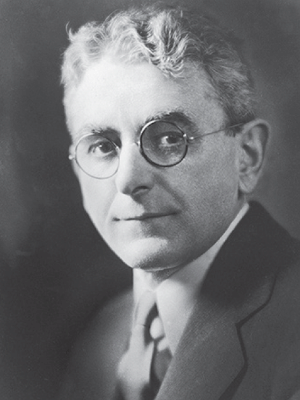
Click below to read the obituary for Dr. Rogers.
Mark Homer Rogers 1877-1941

Dr. Orr served as Editor-in-Chief from 1919 to 1921. During his tenure, the editorial offices were moved to Lincoln, NE, while the business offices remained in Boston.
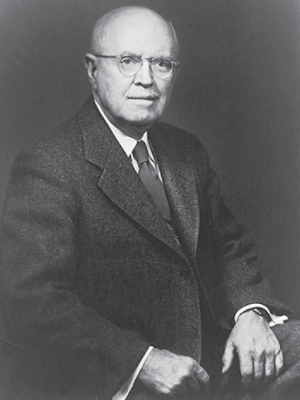
Click below to read the obituary for Dr. Orr, along with an editorial Dr. Orr wrote at the end of his tenure as Editor-in-Chief (1919-1921).
Hiram Winnett Orr 1877-1956
Editorial

Deemed the “first Editor in the modern sense” by the AOA, Dr. Brackett set the tone for JBJS and turned it into the printed mainstay of the orthopaedic surgical community. During his tenure, subscriptions increased from 797 to over 3,300.
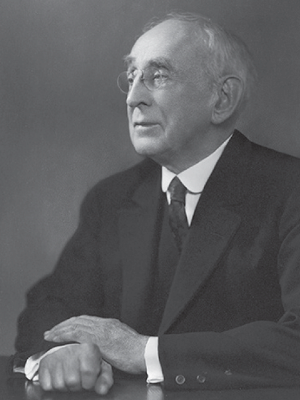
Click below to read the obituary for Dr. Brackett, along with 2 editorials Dr. Brackett wrote during his tenure as Editor-in-Chief (1921-1942).
Elliott Gray Brackett
Editorial Department. Foreword for the Year 1922
Tuberculosis in China

Dr. Rogers coordinated a joint publication with The British Orthopaedic Association. Under his guidance, JBJS also became a nonprofit corporation with its Trustees appointed by The American Orthopaedic Association, its former owner, and The American Academy of Orthopaedic Surgeons.
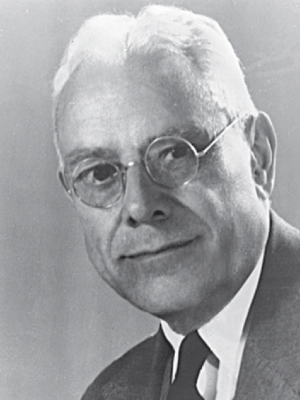
Click below to read the obituary for Dr. Rogers, along with 2 editorials Dr. Rogers wrote during his tenure as Editor-in-Chief (1944-1958).
William Alexander Rogers, M. D. March 30, 1892 to April 4,1975
Editorial Announcement
Editorial

Dr. Brown improved the rapidity of publication of articles by increasing the number of journal issues to 8 per year. Additionally, his meticulous insistence on accuracy and clarity set the highest standards for publishing in JBJS.
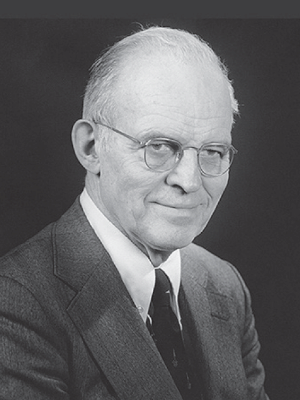
Click below to read the obituary for Dr. Brown, along with an editorial Dr. Brown wrote during his tenure as Editor-in-Chief (1958-1978).
Thornton Brown, M.D., 1913-2000
Editorial

Appointed in 1958, Dr. Brown was a humble leader who set a high standard for editorial excellence and was devoted to the communication of scientific material. During his tenure as Editor-in-Chief, he inculcated the controlled article structure that remains today.
Under Dr. Curtiss, JBJS began to decrease the length of time from submission to publication. He had a lighter hand during line editing than his predecessors and started to accelerate deadlines for author responses to reviewer comments and corrected manuscripts.
Dr. Curtiss established the Current Concepts Reviews and Letters to the Editor sections during his tenure and increased publication to 9 issues per year. He was the first medical editor to suggest that authors disclose potential conflicts of interest.
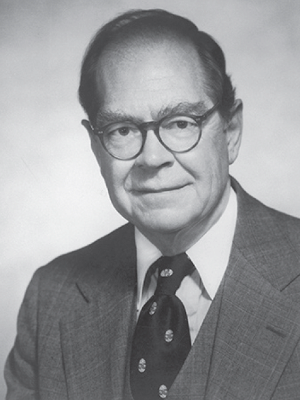
Click below to read the obituary for Dr. Curtiss, along with an editorial Dr. Curtiss wrote during his tenure as Editor-in-Chief (1979-1985).
Paul H. Curtiss Jr., MD 1920-2007
Editorial Announcement

Dr. Cowell brought JBJS into the modern age of electronic publishing. He replaced typewriters with computers, started the JBJS website and put its content on CD-ROMs, introduced desktop publishing, and instituted a computerized database for article tracking.
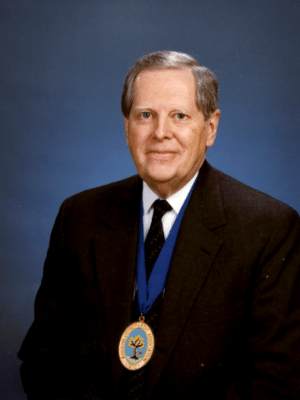
Below are the links to the obituary for Dr. Cowell, along with links to editorials Dr. Cowell wrote during his tenure as Editor-in-Chief (1986-1999).
Henry R. Cowell, MD, PhD 1933-2017
Multiple Authorship of Manuscripts
Patient Care and Scientific Freedom
Electronic Publishing—The Next Step
The Use of Numbers and Percentages in Scientific Writing
Discount Pricing for Residents and Registrars
Electronic Publishing—Another Step
Management of Postoperative Pain in Animals Used in Research

When Henry Cowell became Editor-in-Chief, he also became JBJS’s first CEO, a role that included financial responsibility and ushered in a new age as a thriving corporation and international powerhouse in a highly competitive market.
Under Henry Cowell, Deputy Editor workshops included reviewers and were held around the country and globe, at greater frequency, to improve communication, feedback, and training. He also educated orthopaedists on how to effectively critique manuscripts.
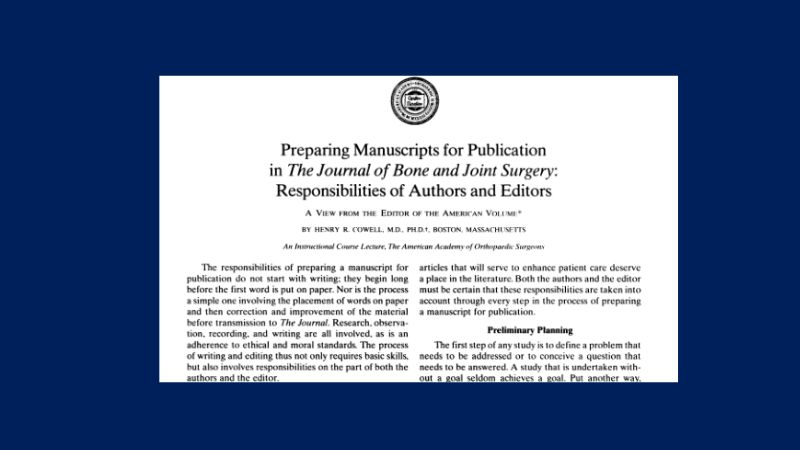
The Deputy Editor workshop became a crucial component of publishing JBJS during Henry Cowell’s leadership as Editor-in-Chief.
During these workshops, Deputy Editors would gather together with reviewers, Associate Editors, and others to resolve disagreements around reviewers’ grades.
Dr. Cowell was intent on increasing the frequency of these workshops and using them to extend The Journal’s outreach among key stakeholders and enhance education on how to effectively critique manuscripts, helping to raise the bar for editorial excellence.
Dr. Cowell also prioritized continuing education for JBJS staff, whether that meant training on new computer technologies or supporting senior staff membership in professional societies and participation in conferences.

Dr. Heckman brought enormous energy and fierce determination to his role as Editor-in-Chief. He encouraged the publication of unbiased research and routine reviews by statisticians. He also intensified efforts to network with other journals with an eye toward best and ethical publishing practices.
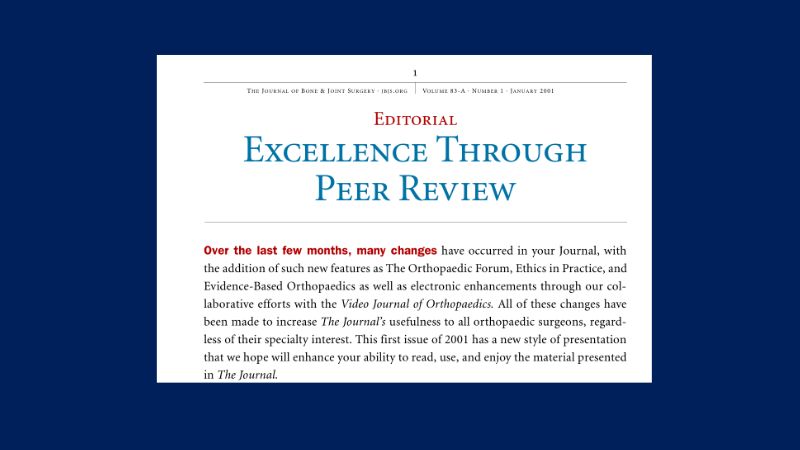

Dr. Heckman spearheaded several important initiatives, including a focus on evidence-based medicine, shortening the time from submission to publication, advancing the integration of print and electronic publication, and expanding the types of articles (Orthopaedic Forum, Ethics in Practice, Evidence-Based Orthopaedics).

Click on read more for links to editorials written by Dr. Heckman during his tenure as Editor-in-Chief (2000-2009).

Under Dr. Heckman’s tenure as Editor-in-Chief, JBJS enhanced the level of evidence published with clinical articles and implemented structured abstracts. During this time, JBJS also launched several new features, including “Orthopaedic Forum,” “Ethics in Practice,” “Evidence-Based Orthopaedics,” and “Specialty Update.”
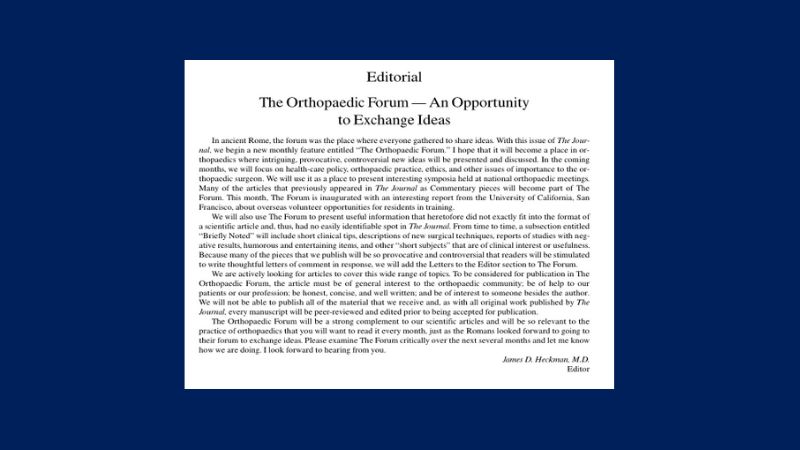
The “Orthopaedic Forum” is designed to be a place where intriguing, provocative, or controversial new ideas are presented and discussed. It includes topics on health care policy, orthopaedic practice, and ethics, and presents interesting symposia from national orthopaedic meetings.
“Ethics in Practice” articles feature topics of benefit to both physicians and patients alike. Typically, each article includes a brief clinical vignette followed by a discussion of the ethical issues that were encountered and how they were addressed.
“Evidence-Based Orthopaedics” articles, published quarterly, feature summaries of the main points of 3 recent studies from the orthopaedic literature, followed by commentaries highlighting the strengths and weaknesses of each study from an evidence-based perspective.“
Specialty Update” articles, published monthly, provide a comprehensive overview of the recent literature pertaining to major subspecialties in the field of orthopaedics.

Dr. Greene appointed and promoted James Heckman as Editor-in-Chief and Mady Tissenbaum as the General Manager of JBJS, Inc. On December 31, 2002, the Board of Trustees froze the Defined Benefit Plan.

Also under Dr. Greene’s guidance, the agreement to make JBJS a member benefit of the AAOS was officially implemented. After a long-standing relationship, the separation of the American and British versions of The Journal of Bone and Joint Surgery began.
During his tenure, Dr. Greene reaffirmed the ongoing mission of JBJS for excellence in scientific publishing and encouraged the discussion of other alternative educational opportunities.

Dr. Herndon created the International Development Committee to expand the global JBJS brand, extended the Joint Publishing Agreement with The British Editorial Society, and extended the AAOS/JBJS Member Benefit Agreement.

Under Dr. Herndon’s guidance, the strategic decision was made to change the traditional business model of JBJS—led by an Editor-in-Chief who also served as CEO—to one where the business functions (CEO & CFO) were separated from the editorial functions (Editor-in-Chief). Kent Anderson was hired as the first CEO/Publisher of JBJS.
To facilitate this change, a new Board committee— the Editorial Advisory Committee—was appointed to maintain open communications between the Editor-in-Chief and the Board of Trustees. Dr. Herndon improved Board communications with monthly conference calls and advanced Board education with strategic discussions led by experts at each annual meeting.

Dr. Tolo continued to shepherd JBJS into the electronic age, most notably during the switch to 2 monthly issues of the flagship journal and the launch of several new electronic-only publications (JBJS Essential Surgical Techniques, JBJS Case Connector, and JBJS Reviews).
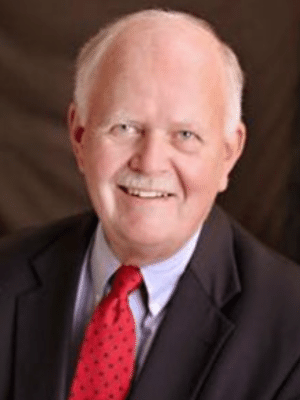
Click on Read More for links to editorials written by Dr. Tolo during his tenure as Editor-in-Chief (2010-2014).

Dr. Weinstein instituted a submission fee for JBJS scientific articles and formed the Editor-in-Chief Search Committee which was formed to replace retiring Editor-in-Chief Vernon Tolo, MD.
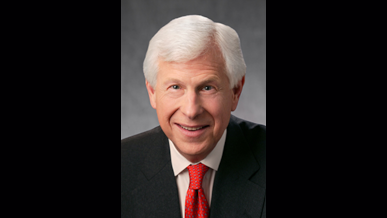
Dr. Weinstein also approved the Peer Review Evaluation Score (preSCORE) initiative to give readers insight into the peer review process around individual articles.
Marc Swiontkowski, MD, was selected by the Editor-in-Chief Search Committee as the next Editor-in-Chief in December 2013.

Dr. Swiontkowski continued the tradition of excellence through the launch of new publications (JBJS Open Access, JBJS JOPA) and educational offerings (JBJS Clinical Classroom, JBJS MRC), all driven by a consistent focus on patient outcomes and practice-changing scientific content.
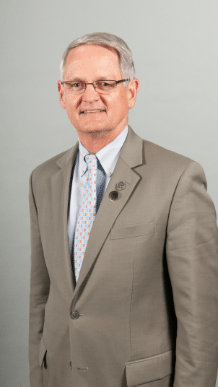
Click on Read More for links to editorials written by Dr. Swiontkowski during his tenure as Editor-in-Chief (2014-present).

After serving as Deputy Editor of JBJS for 18 years, and Editor of JBJS Case Connector for three years, Marc Swiontowski was appointed as Editor-in-Chief. As a trauma surgeon, Dr. Swiontowski was widely known for his role in elucidating the importance of evidence in orthopaedic research.
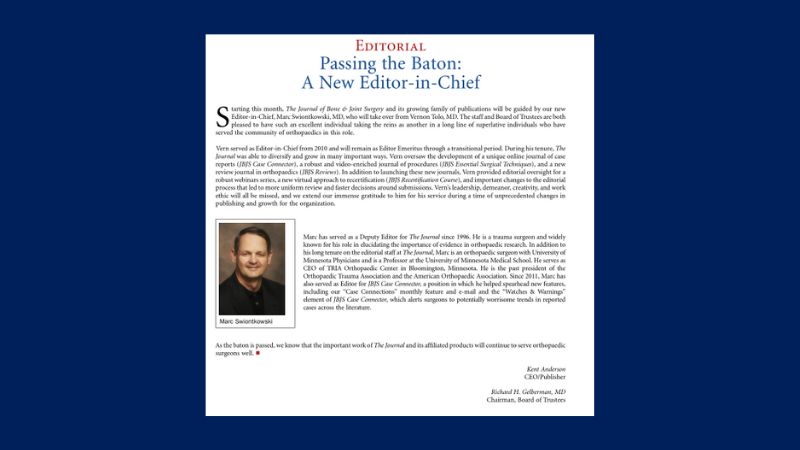

Dr. Swiontkowski discusses key factors to consider when deciding where to submit a manuscript. For complete instructions for authors and other materials, please visit the JBJS Author Resource Center at JBJS.org.
One major trend in the field of orthopaedics is focused on improving research methodology due to more sophisticated analytic approaches. Get the guidance that you need to excel in an evolving field by visiting JBJS.org.
An orthopaedist can become a family resource by taking care of families over generations; from children to grandparents.
Connecting with a patient in providing a surgical or non-surgical solution that results in a good outcome and even more importantly struggling with a patient and their family through a mediocre outcome.
Dr. Swiontkowski recalls having his first manuscript published in the Journal of Pediatric Orthopaedics as 3rd year orthopaedic resident. Ready to get published? Visit the JBJS Author Resource Center at JBJS.org.
Authors play an important role at JBJS. Listen to Dr. Swiontkowski discuss his efforts in support of these valued stakeholders. For complete instructions for authors and other materials, please visit the JBJS Author Resource Center at JBJS.org.
The breadth of orthopaedics encompasses pediatrics, hand, spine, arthroplasty, etc. JBJS delivers complete coverage to a broad field. Please visit JBJS.org.
Our Publisher, Wolters Kluwer, has resources available to provide translation and editorial processes prior to submission. Information on translation services is available at the JBJS Author Resource Center on JBJS.org.
Visual resources that have come about in the last 10-15 years in terms of rich resources for video projection of surgical techniques and assessment of patients has had a huge impact in orthopaedics.
Mohit (Mo) Bhandari, MD, PhD, FRCSC, universally recognized as a leading light in the field of orthopaedic research, officially assumed the role of Editor-in-Chief on June 1, 2024. Dr. Bhandari’s vision is to reimagine The Journal for the modern audience while continuing to further its mission of providing impactful, gold-standard information to the global orthopaedic community.

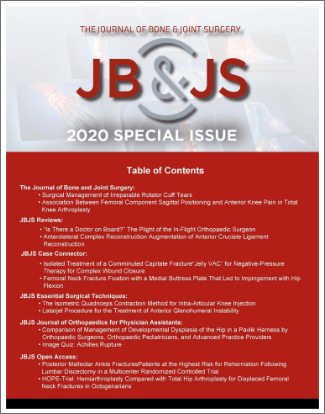
Sign up to receive your free JBJS 2020 Special Issue—a compilation of the most-read articles. You get twelve articles across six JBJS publications in this special issue.